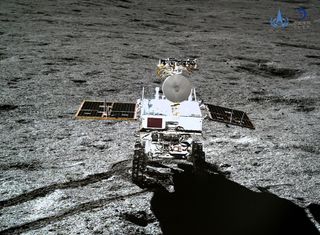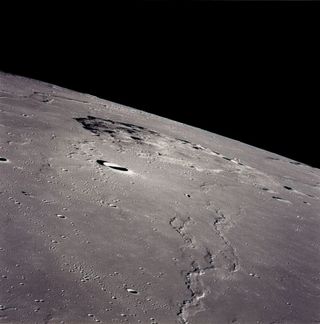
China Details Future Moon Plans, Including Polar Research Station
China's bold moon-exploration plans don't stop with the pioneering Chang'e 4 mission, which made the first-ever soft landing on the lunar far side on Jan. 2.
The State Council Information Office of China (SCIO) held a press conference Monday (Jan. 14) to discuss that epic touchdown, and to give an overview of the nation's future activities on Earth's nearest neighbor.
One of the near-term highlights is the Chang'e 5 sample-return mission, which China aims to launch before the end of the year. [Photos Cina On the Moon! A History of Chinese Lunar Missions in Pictures]
"Experts are still discussing and verifying the feasibility of subsequent projects, but it's confirmed that there will be another three missions after Chang'e 5," Wu Yanhua, deputy head of the China National Space Administration (CNSA), said at the press briefing.
According to Wu, the Chang'e 6 mission will be designed to bring samples back from the moon's south polar region. "Whether the probe will land on the near side or the far side of the moon, we will make the decision according to the performance of Chang'e 5," he said.
As reported by the state-run Xinhua news agency, the Chang'e 7 mission will carry out comprehensive surveys around the moon's south pole, including studying terrain and landforms, the physical composition as well as the space environment in the region.
Research base

The Chang'e 8 mission, in addition to scientific surveys and experiments, will test key technologies to lay the groundwork for the construction of a science and research base on the moon, Xinhua reported.
Get the Space.com Newsletter
Breaking space news, the latest updates on rocket launches, skywatching events and more!
China, the United States, Russia and some European countries all want to try out technologies needed for such a scientific lunar base. "For example, can we build houses on the moon with lunar soil using 3D printing technology?" Wu said.
"We hope that Chang'e 8 will help test some technologies, and do some exploring for the building of a joint lunar base shared by multiple countries," Wu said. [Moon Base Visions: How to Build a Lunar Colony (Photos)]
Rover challenges
Chinese space experts at the SCIO press briefing also noted that the Chang'e 4 rover, known as Yutu 2 ("Jade Rabbit 2"), will face great challenges in its survey of the Von Karman Crater landscape in the South Pole-Aitken Basin.
"From the images sent back from Chang'e 4, we can see the area surrounding the probe is dotted with craters of different sizes, and it's very difficult for the rover to drive in the region," explained Sun Zezhou, chief designer of the Chang'e 4 probe, according to Xinhua.
"We'll try to find the relatively safe areas and make a reasonable plan for the route of the rover based on the images taken by it," Sun said, adding, "we haven't found any insurmountable obstacle in the region."

Science phase
The Chang'e 4 mission is equipped with 13 payloads, including four scientific payloads jointly developed by scientists from the Netherlands, Germany, Sweden, Saudi Arabia and China. [Photos from the Moon's Far Side! China's Chang'e 4 in Pictures]
Wu Weiren, general designer of China's lunar exploration program, said that three major aspects will be carried out by Chang'e 4 as the mission transfers from the commissioning phase to the scientific exploration phase.
First is exploring the topography of the landing area and carrying out a geological profile of the far side. The second, Wu said, is primarily about the space environment around the moon, including the impact of cosmic radiation, solar radiation and solar eruptions on the lunar space. And the third is the study of the material composition of the lunar landscape.
The Chang'e 4 lander and Yutu 2 rover have now entered lunar night, and have gone into a sort of sleep mode as a result. The rover will be reactivated after 14 days when the moon's far side enters daytime.
U.S.-China cooperation?
Meanwhile, China Daily reported that former NASA chief Charles Bolden said that congressional prohibitions on space cooperation with China — as stipulated by the 2011 Wolf Amendment to a NASA appropriations bill — is a "significant legal constraint" and "hindrance" that should be relaxed or reversed, Bolden said.
"I'm incredibly optimistic. I just think cooler heads will prevail," Bolden told China Daily.
A former astronaut, Bolden ran the U.S. space agency from July 2009 to January 2017.
"If this administration went to the Congress and said, 'Look, we want to relax the stipulations on the Wolf Amendment' or 'We want to eliminate the Wolf Amendment,' it could get passed in a heartbeat, and that would remove the restriction and we'd be able to collaborate in human spaceflight," Bolden said, according to China Daily.
"My firm belief is that we should integrate China into the International Space Station program. It doesn't have a lot of time left," Bolden said, referring to the planned retirement of the ISS in a few years. That would help China "avoid some of the mistakes that were made with building the International Space Station," he said in the China Daily story.
You can view Monday's SCIO press briefing here.
Leonard David is author of the forthcoming book, "Moon Rush: The New Space Race" to be published by National Geographic in May 2019. A longtime writer for SPACE.com, David has been reporting on the space industry for more than five decades. Follow us @Spacedotcom or Facebook. This version of the story published on Space.com.
Join our Space Forums to keep talking space on the latest missions, night sky and more! And if you have a news tip, correction or comment, let us know at: community@space.com.

Leonard David is an award-winning space journalist who has been reporting on space activities for more than 50 years. Currently writing as Space.com's Space Insider Columnist among his other projects, Leonard has authored numerous books on space exploration, Mars missions and more, with his latest being "Moon Rush: The New Space Race" published in 2019 by National Geographic. He also wrote "Mars: Our Future on the Red Planet" released in 2016 by National Geographic. Leonard has served as a correspondent for SpaceNews, Scientific American and Aerospace America for the AIAA. He was received many awards, including the first Ordway Award for Sustained Excellence in Spaceflight History in 2015 at the AAS Wernher von Braun Memorial Symposium. You can find out Leonard's latest project at his website and on Twitter.
